It’s a simple trick, but it comes with a few stipulations that you should know about before you just jump in with both feet.
Your blender can replace almost every function that your food processor can do, and with a Vitamix or Ninja, it can arguably do it even better.
Grinding meat yourself ensures a fantastic taste and texture, especially since it’s not sitting in some thin plastic wrap when it’s pre-ground at the supermarket.
You’ll be able to add your spices and necessary ingredients into your meat during grinding, making it even better when it comes time to cook it. Let’s get started.
Can You Grind Meat in Your Blender?
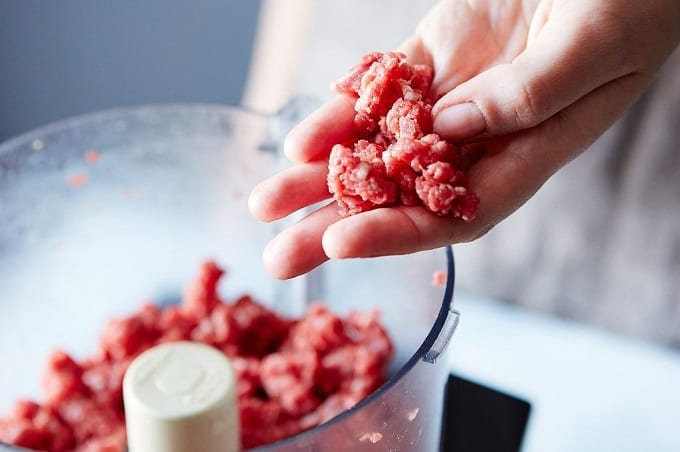
You most certainly can, but it’s not just as simple as tossing it in the blender and turning it on.
You need to make sure that your blender can handle it before you even get started. Then, you need to look at the volume and type of meat that you’ll be blending.
So let’s look at your blender first of all.
How powerful is the motor, and how sharp are the blades?
Your blades have to be sharpened or relatively new if you’re going to grind meat.
Most blenders rely on the friction that the blades create to cut through the food that’s introduced (blades usually crush ice instead of chopping or cutting it, for example).
Whether you’re going for a shaved steak type of consistency or full-on ground beef, it’s all going to depend on the motor and blades.
Cheap department store blenders won’t be able to handle more than about six to eight ounces of meat at a time.
They keep costs low because they introduce basic and low power motors into their models, allowing for cheap mass production.
Meat can give resistance by making it harder for the blades to spin, and overworking the motor.
A top tier blender will usually be able to draw additional power when the motor is facing resistance, which offers consistency.
Now, what type of meat are you blending?
Chicken and turkey will be dead simple to grind; it breaks apart very easily, so you won’t run into any problems. If you’re blending steak, it’s going to take a while no matter what blender you have.
You want to be able to grind at least one pound at a time, but don’t overload it or you’ll end up with inconsistent results.
How to Prepare Meat for Blending
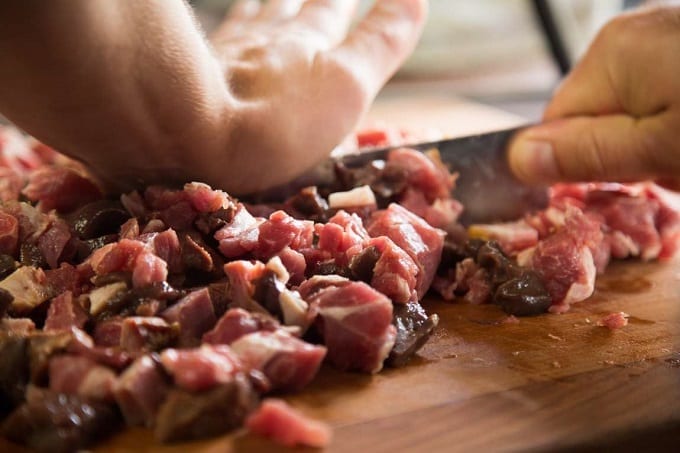
Chop it up into small pieces.
For steak or any other beef type, you want to cube it prior to tossing it in the blender. Just because the blades can work to cut up and grind meat does not mean that it’s what it was built for.
Once it’s cubed, place it on a piece of tin foil and put it in the freezer for about ten to fifteen minutes.
After chopping it up, you’ll notice that the texture changed and it’s a bit softer now. We want it to be a bit firmer for when it meets the blender blades.
One thing you should avoid is marinating the meat before blending it.
There are a few articles online that say you should soak it in olive oil and then toss it in the grinder, but it’s just going to turn it into a meat paste.
It’s good if you’re marinating and then throwing it straight on the stove or grill, but not if it’s going to blended.
Reasons Why Blender-Ground Meat is Better
Blending ground meat is superior to buying it from the supermarket for a few reasons.
Not only is it a more intimate way to control the quality of your food, but you can blend in spices right into the meat while it grinds, among other things.
These are the main reasons why blending your own meat is better.
Health
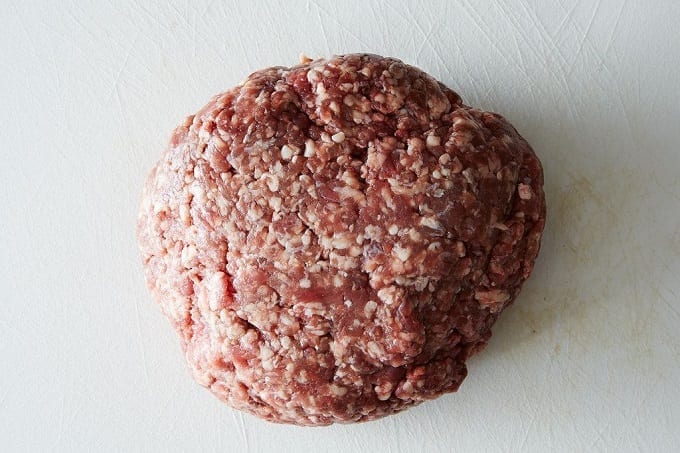
How clean are the grinders at the supermarket and food processing plants? You’ll never know. How clean is your blender?
That, you can control.
Beyond the grinding process, meat sitting in a thin layer of plastic and styrofoam starts to grow bacteria. Even in the cold, even when the temperature range is good, this starts to happen.
If you buy the meat whole, you’ll be able to grind it up and use it immediately, reducing any risk of getting bad meat.
If you can buy a quarter or half of a cow and fill up your deep freezer, that’s even better. It’s as personal as you can get with your meat.
Taste
With less time spent on the grocery store shelves, you don’t end up with sad-looking gray ground beef.
We’ve all come across it, some of us have bought it, and the flavor is sorely lacking.
Salt and pepper work well to season your meat, but there’s an inherent meat flavor that’s sorely lacking when you get pre-ground beef from the supermarket.
Guess what?
You get to control the taste from now on, especially if you grind it up as soon as you purchase it.
Cost
You’re paying a convenience fee to get that meat ground up for you.
They pay butchers, pay for extra packaging (the packaging that the meat comes in, plus the containers they’re putting it in), and people to stock the shelves.
Cut all of that out, and the cost gets brought down by a decent amount. In bulk, the more you purchase (buying a quarter of a cow and so on), the more money you can save.
Appearance
You aren’t going to get points for aesthetics if the meat looks all gray and gross. You’ll retain that reddish pink color throughout grinding, which will sear into a glorious brown during cooking.
If you did a side-by-side comparison between meat that you grind, and pre-ground meat at the store, you’d be amazed at how different it looks.
Does Fat Content Matter During Blending?
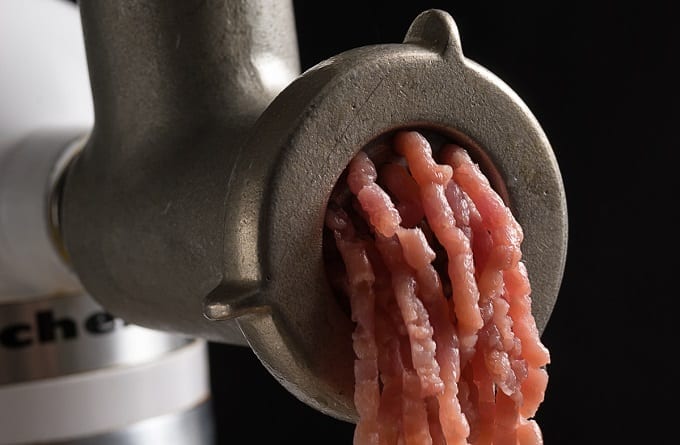
Yes, it does.
The fattier the meat, the more residue is going to be left behind after you’ve ground up the actual meat. This could clog the blender blades up, and it makes cleaning a lot more difficult.
Even though the fat hasn’t been cooked and heated to coat everything, it’s still stubborn to get out of the blender pitcher.
Can You Blend Meat After It’s Cooked?
You absolutely can blend meat after it’s been cooked.
It will be easier to grind when it is raw, but cooked meat (provided you don’t char it) can still be cut up into similar sized pieces by a powerful blender motor and blades.
You’ll be able to get the same consistency, although the flavor might be diminished since you’re also grinding up the seasoning on the meat.
What’s the Best Meat for Blending?
Sirloin is by far the best for blending.
It’s low in fat, so it doesn’t stick to the blades or the inside of the pitcher very much. You’ll be able to grind this up fairly easily, but when it comes time to cook it, you might get a slightly dry consistency.
The beef flavor is excellent, but you still need a little bit of fat to the cook-off. Mixing sirloin with a 90/10 beef will give a good amount of fat without making the end product overly greasy.
How to Fix Tough Meat?
Tough meat is going to a cookout to be pretty dry, but you’ve got a blender, so you can prevent that from ever happening.
Add one tablespoon of water at a time while blending the meat until you reach a softer, better consistency.
Use the pulse setting when doing this so you don’t emulsify the meat until it’s even tougher.
You can also add a bit of olive oil to the meat after it’s left the pitcher, and let the air get at it for about thirty minutes.
It takes four hours for food to grow dangerous levels of bacteria in room temperature environments, so thirty minutes won’t harm your meat. It should be tender now.
What’s the Best Blender for Blending Meat?
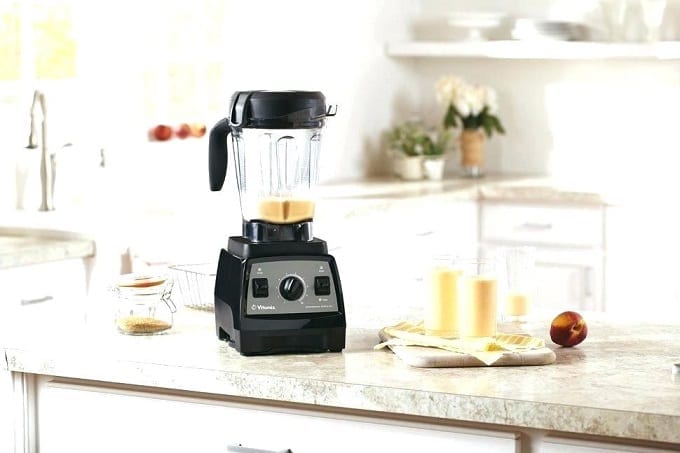
Vitamix has an excellent unit, the Pro 750, which not only handles a variety of other dishes and preparations but also grinds meat without even the slightest bit of hesitation from the motor.
Vitamix is up to handle the challenge and offers 64 oz blender pitchers for bulk blending.
You won’t have to grind in 8 oz batches—there’s more power in a Vitamix Pro 750 than most blenders that exist on the market today.
Doing It All Yourself
Your blender can do it all, but of course, it’s about the operator as much as it’s about the equipment.
With a high-powered blender, there’s nothing in your kitchen that you won’t be able to achieve.
Look for attachments if you have a Vitamix blender, so you can bring your culinary bliss one step closer to perfection.
Subscribe To Stumpf Studio Newsletter
By entering your email address you agree to get email updates from Stumpf Studio. We'll respect your privacy and unsubscribe at any time.
